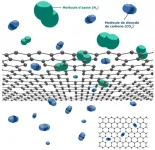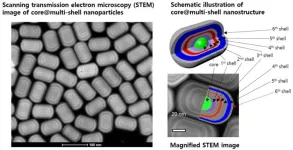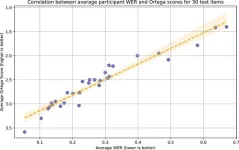(Press-News.org) CAMBRIDGE, MA -- Bacteria can be engineered to sense a variety of molecules, such as pollutants or soil nutrients. In most cases, however, these signals can only be detected by looking at the cells under a microscope or similarly sensitive lab equipment, making them impractical for large-scale use.
Using a new method that triggers cells to produce molecules that generate unique combinations of color, MIT engineers have shown that they can read out these bacterial signals from as far as 90 meters away. Their work could lead to the development of bacterial sensors for agricultural and other applications, which could be monitored by drones or satellites.
“It’s a new way of getting information out of the cell. If you’re standing next to it, you can’t see anything by eye, but from hundreds of meters away, using specific cameras, you can get the information when it turns on,” says Christopher Voigt, head of MIT’s Department of Biological Engineering and the senior author of the new study.
In a paper appearing today in Nature Biotechnology, the researchers showed that they could engineer two different types of bacteria to produce molecules that give off distinctive wavelengths of light across the visible and infrared spectra of light, which can be imaged with hyperspectral cameras. These reporting molecules were linked to genetic circuits that detect nearby bacteria, but this approach could also be combined with any existing sensor, such as those for arsenic or other contaminants, the researchers say.
“The nice thing about this technology is that you can plug and play whichever sensor you want,” says Yonatan Chemla, an MIT postdoc who is one of the lead authors of the paper. “There is no reason that any sensor would not be compatible with this technology.”
Itai Levin PhD ’24 is also a lead author of the paper. Other authors include former undergraduate students Yueyang Fan ’23 and Anna Johnson ’22, and Connor Coley, an associate professor of chemical engineering at MIT.
Hyperspectral imaging
There are many ways to engineer bacterial cells so that they can sense a particular chemical. Most of these work by connecting detection of a molecule to an output such as green fluorescent protein (GFP). These work well for lab studies, but such sensors can’t be measured from long distances.
For long-distance sensing, the MIT team came up with the idea to engineer cells to produce hyperspectral reporter molecules, which can be detected using hyperspectral cameras. These cameras, which were first invented in the 1970s, can determine how much of each color wavelength is present in any given pixel. Instead of showing up as simply red or green, each pixel contains information on hundreds different wavelengths of light.
Currently, hyperspectral cameras are used for applications such as detecting the presence of radiation. In the areas around Chernobyl, these cameras have been used to measure slight color changes that radioactive metals produce in the chlorophyll of plant cells. Hyperspectral cameras are also used to look for signs of malnutrition or pathogen invasion in plants.
That work inspired the MIT team to explore whether they could engineer bacterial cells to produce hyperspectral reporters when they detect a target molecule.
For a hyperspectral reporter to be most useful, it should have a spectral signature with peaks in multiple wavelengths of light, making it easier to detect. The researchers performed quantum calculations to predict the hyperspectral signatures of about 20,000 naturally occurring cell molecules, allowing them to identify those with the most unique patterns of light emission. Another key feature is the number of enzymes that would need to be engineered into a cell to get it to produce the reporter — a trait that will vary for different types of cells.
“The ideal molecule is one that’s really different from everything else, making it detectable, and requires the fewest number of enzymes to produce it in the cell,” Voigt says.
In this study, the researchers identified two different molecules that were best suited for two types of bacteria. For a soil bacterium called Pseudomonas putida, they used a reporter called biliverdin — a pigment that results from the breakdown of heme. For an aquatic bacterium called Rubrivivax gelatinosus, they used a type of bacteriochlorophyll. For each bacterium, the researchers engineered the enzymes necessary to produce the reporter into the host cell, then linked them to genetically engineered sensor circuits.
“You could add one of these reporters to a bacterium or any cell that has a genetically encoded sensor in its genome. So, it might respond to metals or radiation or toxins in the soil, or nutrients in the soil, or whatever it is you want it to respond to. Then the output of that would be the production of this molecule that can then be sensed from far away,” Voigt says.
Long-distance sensing
In this study, the researchers linked the hyperspectral reporters to circuits designed for quorum sensing, which allow cells to detect other nearby bacteria. They have also shown, in work done after this paper, that these reporting molecules can be linked to sensors for chemicals including arsenic.
When testing their sensors, the researchers deployed them in boxes so they would remain contained. The boxes were placed in fields, deserts, or on the roofs of buildings, and the cells produced signals that could be detected using hyperspectral cameras mounted on drones. The cameras take about 20 to 30 seconds to scan the field of view, and computer algorithms then analyze the signals to reveal whether the hyperspectral reporters are present.
In this paper, the researchers reported imaging from a maximum distance of 90 meters, but they are now working on extending those distances.
They envision that these sensors could be deployed for agricultural purposes such as sensing nitrogen or nutrient levels in soil. For those applications, the sensors could also be designed to work in plant cells. Detecting landmines is another potential application for this type of sensing.
Before being deployed, the sensors would need to undergo regulatory approval by the U.S. Environmental Protection Agency, as well as the U.S. Department of Agriculture if used for agriculture. Voigt and Chemla have been working with both agencies, the scientific community, and other stakeholders to determine what kinds of questions need to be answered before these technologies could be approved.
“We’ve been very busy in the past three years working to understand what are the regulatory landscapes and what are the safety concerns, what are the risks, what are the benefits of this kind of technology?” Chemla says.
###
The research was funded by the U.S. Department of Defense, the U.S. Army Research Office, and the Ministry of Defense of Israel.
END
Engineered bacteria emit signals that can be spotted from a distance
These bacteria, which could be designed to detect pollution or nutrients, could act as sensors to help farmers monitor their crops
2025-04-11
ELSE PRESS RELEASES FROM THIS DATE:
Scalable graphene membranes: a leap for carbon capture
2025-04-11
Capturing carbon dioxide (CO₂) from industrial emissions is crucial in the fight against climate change. But current methods, like chemical absorption, are expensive and energy-intensive. Scientists have long eyed graphene—an atom-thin, ultra-strong material—as a promising alternative for gas separation, but making large-area, efficient graphene membranes has been a challenge.
Now, a team at EPFL, led by Professor Kumar Agrawal, has developed a scalable technique to create porous graphene membranes ...
Early detection of Parkinson’s with novel RNA-based blood test
2025-04-11
Researchers have developed a simple and cost-effective blood test capable of detecting Parkinson’s disease long before symptoms emerge, comparing the current state of diagnosing neurodegenerative diseases to the fight against cancer 50 years ago—when most cases were identified too late for effective treatment. The test quantifies specific RNA fragments in the blood, focusing on a repetitive RNA sequence that accumulates in Parkinson’s patients and a parallel decline in mitochondrial RNA, which deteriorates as the disease progresses. By measuring the ratio between these biomarkers, the test offers a highly accurate, non-invasive, rapid and affordable diagnostic tool, ...
“Internet of nature” helps researchers explore the web of life
2025-04-11
A novel paper led by Dr Ulrich Brose of the German Centre for Integrative Biodiversity Research (iDiv) and the Friedrich Schiller University Jena is widening understanding of how species interact within ecosystems via the so-called “Internet of Nature.” Published in Nature Ecology and Evolution, the paper reveals that species not only exchange matter and energy but also share vital information that influences behaviour, interactions, and ecosystem dynamics – revealing previously hidden characteristics of natural ecosystems.
Traditionally, ecological studies have ...
Police officers face twice the risk of traumatic brain injuries and PTSD, survey finds
2025-04-11
Police officers are more than twice as likely to have traumatic brain injuries compared to the general population. Officers who incur these injuries while on duty face more than double the risk of developing complex post-traumatic stress disorder (PTSD).
That’s according to a new survey-based study from the University of Exeter, published in The Journal of Head Trauma Rehabilitation, which found a connection between traumatic brain injuries and PTSD in police officers. Authors say the findings ...
Patrick Tan appointed as Duke-NUS Dean to lead next era of medical innovation and education
2025-04-11
SINGAPORE, 11 APRIL 2025—Duke-NUS Medical School has appointed Professor Patrick Tan as its next and fourth Dean, effective 1 January 2026, marking a new chapter for the School as it builds on its legacy of medical education, research and innovation. Prof Tan will serve as Dean-designate from 1 July 2025, succeeding Professor Thomas Coffman, the School’s longest-serving Dean since 2015. This leadership transition coincides with the School’s 20th anniversary, underscoring Duke-NUS’ commitment to advancing ...
Development of a novel modified selective medium cefixime–tellurite-phosphate-xylose-rhamnose MacConkey agar for isolation of Escherichia albertii and its evaluation with food samples
2025-04-11
Since cefixime and tellurite are known to inhibit most bacteria belonging to Enterobacterales, we found that addition of tellurite inhibited E. albertii growth in Luria Bertani broth but not in tryptic soy broth (TSB), and addition of phosphate and soy peptone enhanced E. albertii growth in TSB in presence of tellurite.
Subsequently, to find the positive factor present in TSB, E. albertii growth was examined in tryptone, soy peptone, glucose, or phosphate deficient tryptic soy agar plates. Phosphate, soy peptone, and/or ...
KIST develops full-color-emitting upconversion nanoparticle technology for color displays with ultra-high color reproducibility
2025-04-11
Dr. Ho Seong Jang and colleagues at the Extreme Materials Research Center at the Korea Institute of Science and Technology (KIST) have developed an upconversion nanoparticle technology that introduces a core@multi-shell nanostructure, a multilayer structure in which multiple layers of shells surround a central core particle, and enables high color purity RGB light emission from a single nanoparticle by adjusting the infrared wavelength.
Luminescent materials are materials that light up on their own and are used in a variety of display devices, including TVs, tablets, monitors, and smartphones, to allow us to view a variety of images ...
Towards a fully automated approach for assessing English proficiency
2025-04-11
In today’s increasingly interconnected world, language learning has become essential for education, business, and cultural exchange. However, accurately measuring proficiency in language learners is a complex matter. One particularly valuable approach involves asking learners to listen to sentences and then repeat them back as accurately as possible. Known as elicited imitation (EI), this method reveals much more than mere memory and mimicking abilities. When sentences exceed our working memory capacity—typically beyond 8 to 10 syllables—successful repetition requires learners to quickly process and ...
Increase in alcohol deaths in England an ‘acute crisis’
2025-04-10
The persistent higher rate of alcohol deaths in England since the pandemic in 2020 is an “acute crisis” requiring urgent action from government, according to a new study led by researchers at UCL and the University of Sheffield.
For the study, published in Lancet Public Health, researchers analysed Office for National Statistics (ONS) figures of deaths caused solely by alcohol in England. They found that death rates were stable between 2009 and 2019, but increased by a fifth in 2020, rising by a further 13.5% between 2020 and 2022.
The team estimated that 3,911 more people had died solely because of alcohol in England ...
Government urged to tackle inequality in ‘low-carbon tech’ like solar panels and electric cars
2025-04-10
Decarbonisation in the automotive and housing sectors is paramount if the UK’s legally binding commitment to achieving net zero by 2050 is to succeed, say researchers at University of Sheffield
Exploring the presence of socioeconomic inequalities in the uptake of low-carbon technologies (LCTs), such as solar panels and electric vehicles, has important policy implications for the decarbonisation in the UK
The new report advocates for interventions at an individual, as well as community-level, to help those from more disadvantaged backgrounds adopt technologies that ...
LAST 30 PRESS RELEASES:
Common brain parasite can infect your immune cells. Here's why that's probably OK
International experts connect infections and aging through cellular senescence
An AI–DFT integrated framework accelerates materials discovery and design
Twist to reshape, shift to transform: Bilayer structure enables multifunctional imaging
CUNY Graduate Center and its academic partners awarded more than $1M by Google.org to advance statewide AI education through the Empire AI consortium
Mount Sinai Health system receives $8.5 million NIH grant renewal to advance research on long-term outcomes in children with congenital heart disease
Researchers develop treatment for advanced prostate cancer that could eliminate severe side effects
Keck Medicine of USC names Christian Pass chief financial officer
Inflatable fabric robotic arm picks apples
MD Anderson and SOPHiA GENETICS announce strategic collaboration to accelerate AI-driven precision oncology
Oil residues can travel over 5,000 miles on ocean debris, study finds
Korea University researchers discover that cholesterol-lowering drug can overcome chemotherapy resistance in triple-negative breast cancer
Ushikuvirus: A newly discovered giant virus may offer clues to the origin of life
Boosting the cell’s own cleanup
Movement matters: Light activity led to better survival in diabetes, heart, kidney disease
Method developed to identify best treatment combinations for glioblastoma based on unique cellular targets
Self-guided behavioral app helps children with epilepsy sleep earlier
Higher consumption of food preservatives is associated with an increased risk of type 2 diabetes
NTU Singapore-led team captures first-ever ‘twitch’ of the eye’s night-vision cells as they detect light, paving the way for earlier detection of blindness-causing diseases
Global aviation emissions could be halved through maximising efficiency gains, new study shows
Fewer layovers, better-connected airports, more firm growth
Exposure to natural light improves metabolic health
As we age, immune cells protect the spinal cord
New expert guidance urges caution before surgery for patients with treatment-resistant constipation
Solar hydrogen can now be produced efficiently without the scarce metal platinum
Sleeping in on weekends may help boost teens’ mental health
Study: Teens use cellphones for an hour a day at school
After more than two years of war, Palestinian children are hungry, denied education and “like the living dead”
The untold story of life with Prader-Willi syndrome - according to the siblings who live it
How the parasite that ‘gave up sex’ found more hosts – and why its victory won’t last
[Press-News.org] Engineered bacteria emit signals that can be spotted from a distanceThese bacteria, which could be designed to detect pollution or nutrients, could act as sensors to help farmers monitor their crops



